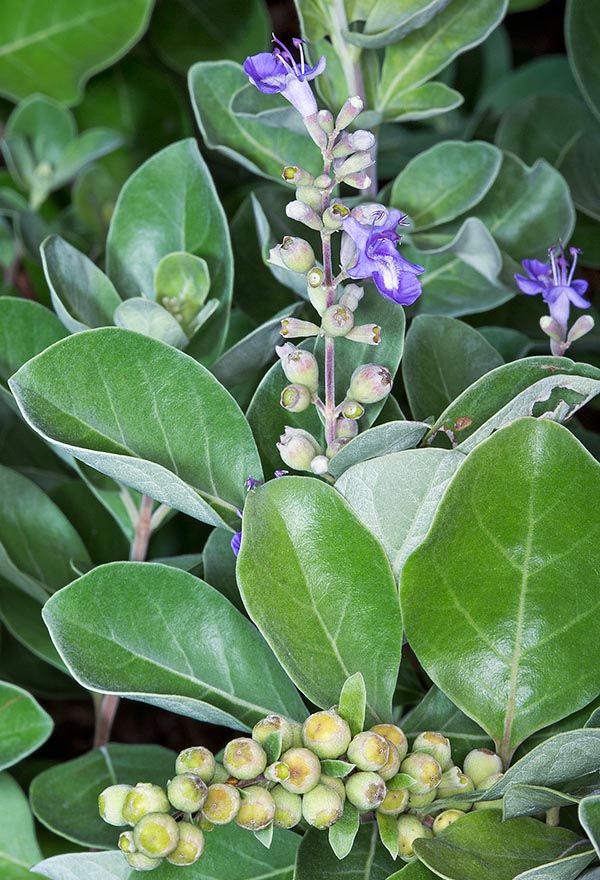Family : Lamiaceae

Text © Pietro Puccio

English translation by Mario Beltramini

Vitex trifolia is a south-east Asian evergreen 2-5 m shrub © Giuseppe Mazza
The species is native to Afghanistan, Australia, Bangladesh, China (Anhui, Fujian, Guangdong, Guangxi, Hebei, Jiangsu, Jiangxi, Liaoning, Shandong, Yunnan and Zhejiang), India (Andaman Islands, Assam, Gujarat, Haryana, Karnataka, Kerala, Maharashtra, Nicobar Islands, Punjab, Tamil Nadu and Western Bengal), Indonesia (Java, Kalimantan, Lesser Sunda Islands, Moluccas, Piccole Sulawesi and Sumatra), Iran, Japan (Honshu, Kyushu, Ryukyu Islands and Shikoku), Malaysia, Myanmar, New Guinea, Philippines, Sri Lanka, Taiwan and Thailand where it lives along the coasts on the dunes and in the hinterland in the forests and prairies, mainly on sandy or rocky soils, up to about 1000 m of altitude.
The name of the genus is the Latin name given by Pliny to the Chaste tree (Vitex agnus-castus L.), coming from the Latin verb “vieo” = to bind, to tie, with reference to the use of the branches for fabricating baskets; the specific name is the combination of the Latin numeral adjective “tres” = three and of the substantive “ folium, ii” = leaf.
Common names: hand-of-Mary, Indian lilac, Indian-privet, Indian three-leaf vitex, Indian wild pepper, simpleleaf chastetree, three-leaved chaste tree (English); man jing, san ye man jing (China); dangla, lagunding-dagat (Philippines); asla, chiruvavili, karunocci, neerinochi, nirgundi, schiru-vavili, surasa, vaavili (India); galumi, legundi (Indonesia); mitsu-ba-hama-go (Japan); lagundi, lemuning, lenggundi (Malaysia); pitipitikoto (Papua New Guinea); khon dinso, phee suea noi (Thailand).
The Vitex trifolia L. (1753) is a shrub or a small evergreen or briefly deciduous tree, 2-5 m tall, with grey to brown bark; the young branches are tomentose. The leaves, on a 1-3 cm long petiole, are opposite, (1-)3(-5)-foliate with sessile leaflets from obovate to lanceolate with obtuse apex and entire margin, central leaflet 3-9 cm long and 1,5-3 cm broad, the lateral ones smaller, of green colour and glossy above, covered by a thick whitish tomentum below, aromatic. Terminal panicle inflorescences, 3-18 cm long, with tomentose peduncle and rachis, bearing numerous flowers with campanulate calyx, 0,5 cm long, externally pubescent and with 5 tiny small tooths on the margin, five lobed corolla, 1-1,2 cm long, white externally, blue or lavender inside, the central lobe, bigger, has a white spot at the base, and 4 prominent stamina. The fruits are subglobose drupes with persistent calyx, of 0,5 cm of diameter, black when ripe, containing 5 black seeds.
It reproduces by seed, that has a short germinability, in sandy loam maintained humid at the temperature of 24-26 °C, and by apical cutting.
Amply cultivated as ornamental in the zones with tropical, subtropical and marginally warm temperate climates, where adult plants can bear for short time temperatures around the -3 °C, slightly lower values can destroy the aerial part, but with regrowth from the base in spring.

Terminal inflorescences with blue-lavender corolla and subglobose fuits, used since remote times, with proved anti-inflammatory and analgesic properties. From the leaves they get an insecticide © G. Mazza
It requires full sun, for a compact appearance and abundant blooming, and preferably sandy and fertile soils, bears the saltiness and, well rooted, periods of drought, utilizable as isolated specimen or for fences and borders; very appreciated are the varieties with white variegated leaves and those with tomentum of purple colour. The prolonged contact with the leaves may cause allergic reactions in the more sensitive persons. The species and its varieties adapt well to the cultivation in pot utilizing a particularly draining loam rich of organic substance; the waterings must be regular, but without stagnations.
Parts of the plant, particularly the dried ripe fruit, are utilized since remote times in the traditional medicine of the populations of the origin countries for various pathologies, such as migraine, cold illnesses, rheumatisms and bruises; laboratory studies have evidenced in the extracts anti-inflammatory and analgesic properties. Locally, the leaves are burnt to keep away the insects, and actually the essential oil extracted from the leaves has high insecticide activity.
Synonyms: Vitex indica Mill. (1768); Vitex integerrima Mill. (1768); Vitex paniculata Lam. (1788); Vitis triphylla Noronha (1790); Vitex variifolia Salisb. (1796); Vitex bicolor Willd. (1809); Vitex triphylla Royle (1836); Vitex trifolia var. acutifolia Benth. (1870); Vitex trifolia var. parviflora Benth. (1870); Vitex agnus-castus var. trifolia (L.) Kurz (1877); Vitex agnus-castus var. javanica Kuntze (1891); Vitex agnus-castus var. subtrisecta Kuntze (1891); Vitex langundi W.G.Maxwell (1906); Vitex neocaledonica Gand. (1918); Vitex negundo var. bicolor (Willd.) H.J.Lam (1919); Vitex benthamiana Domin (1928); Vitex petiolaris Domin (1928); Vitex iriomotensis Ohwi (1938); Vitex rotundifolia var. heterophylla Mak. (1940); Vitex trifolia subsp. trifolia (1941); Vitex trifolia var. bicolor (Willd.) Moldenke (1942); Vitex rotundifolia var. heterophylla Makino ex H.Hara (1948); Vitex trifolia var. heterophylla (Makino ex H.Hara) Moldenke (1949); Vitex trifolia f. albiflora Moldenke (1961); Vitex trifolia var. subtrisecta (Kuntze) Moldenke (1961); Vitex rotundifolia f. heterophylla (Makino ex H.Hara) Kitam. (1972); Vitex negundo var. philippinensis Moldenke (1978).
→ To appreciate the biodiversity within the family LAMIACEAE please click here.
